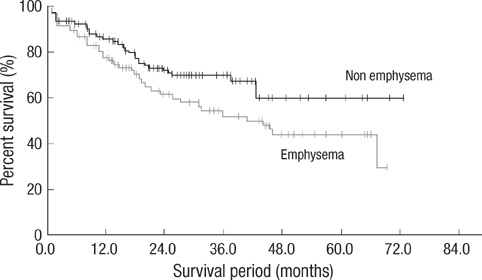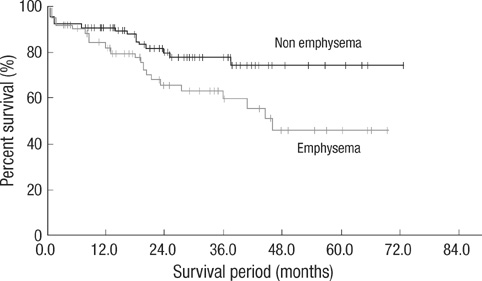J Korean Med Sci.
2010 Aug;25(8):1146-1151. 10.3346/jkms.2010.25.8.1146.
Emphysema as a Risk Factor for the Outcome of Surgical Resection of Lung Cancer
- Affiliations
-
- 1Department of Internal Medicine, Seoul National University College of Medicine, Seoul, Korea.
- 2Department of Radiology, Ajou University School of Medicine, Suwon, Korea.
- 3Department of Pulmonary and Critical Care Medicine, Ajou University School of Medicine, Suwon, Korea. lungmd@ajou.ac.kr
- 4Department of Thoracic and Cardiovascular Surgery, Ajou University School of Medicine, Suwon, Korea.
- KMID: 1714034
- DOI: http://doi.org/10.3346/jkms.2010.25.8.1146
Abstract
- It is unclear whether emphysema, regardless of airflow limitation, is a predictive factor associated with survival after lung cancer resection. Therefore, we investigated whether emphysema was a risk factor associated with the outcome after resection for lung cancer. This study enrolled 237 patients with non small cell lung cancer with stage I or II who had surgical removal. Patient outcome was analyzed based on emphysema. Emphysema was found in 43.4% of all patients. Patients with emphysema were predominantly men and smokers, and had a lower body mass index than the patients without emphysema. The patients without emphysema (n=133) survived longer (mean 51.2+/-3.0 vs. 40.6+/-3.1 months, P=0.042) than those with emphysema (n=104). The univariate analysis showed a younger age, higher FEV1/FVC, higher body mass index, cancer stage I, and a lower emphysema score were significant predictors of better survival. The multivariate analysis revealed a younger age, higher body mass index, and cancer stage I were independent parameters associated with better survival, however, emphysema was not. This study suggests that unfavorable outcomes after surgical resection of lung cancer should not be attributed to emphysema itself.
Keyword
MeSH Terms
Figure
Reference
-
1. Parker SL, Tong T, Bolden S, Wingo PA. Cancer statistics, 1997. CA Cancer J Clin. 1997. 47:5–27.
Article2. Parkin DM, Bray F, Ferlay J, Pisani P. Global cancer statistics, 2002. CA Cancer J Clin. 2005. 55:74–108.
Article3. Reilly JJ. Preparing for pulmonary resection: preoperative evaluation of patients. Chest. 1997. 112:4 Suppl. S206–S208.4. Colice GL, Shafazand S, Griffin JP, Keenan R, Bolliger CT. Physiologic evaluation of the patient with lung cancer being considered for resectional surgery: ACCP evidenced-based clinical practice guidelines (2nd edition). Chest. 2007. 132:3 Suppl. S161–S177.5. British Thoracic Society. BTS guidelines: guidelines on the selection of patients with lung cancer for surgery. Thorax. 2001. 56:89–108.6. Mountain CF. A new international staging system for lung cancer. Chest. 1986. 89:4 Suppl. S225–S233.
Article7. Mountain CF. Revisions in the International System for Staging Lung Cancer. Chest. 1997. 111:1710–1717.
Article8. Standards for the diagnosis and care of patients with chronic obstructive pulmonary disease (COPD) and asthma. This official statement of the American Thoracic Society was adopted by the ATS Board of Directors, November 1986. Am Rev Respir Dis. 1987. 136:225–244.9. Rabe KF, Hurd S, Anzueto A, Barnes PJ, Buist SA, Calverley P, Fukuchi Y, Jenkins C, Rodriguez-Roisin R, van Weel C, Zielinski J. Global strategy for the diagnosis, management, and prevention of chronic obstructive pulmonary disease: GOLD executive summary. Am J Respir Crit Care Med. 2007. 176:532–555.10. American Thoracic Society. Standardization of Spirometry, 1994 Update. Am J Respir Crit Care Med. 1995. 152:1107–1136.11. Sakai F, Gamsu G, Im JG, Ray CS. Pulmonary function abnormalities in patients with CT-determined emphysema. J Comput Assist Tomogr. 1987. 11:963–968.
Article12. Klein JS, Gamsu G, Webb WR, Golden JA, Muller NL. High-resolution CT diagnosis of emphysema in symptomatic patients with normal chest radiographs and isolated low diffusing capacity. Radiology. 1992. 182:817–821.
Article13. Lamers RJ, Thelissen GR, Kessels AG, Wouters EF, van Engelshoven JM. Chronic obstructive pulmonary disease: evaluation with spirometrically controlled CT lung densitometry. Radiology. 1994. 193:109–113.
Article14. Moro-Sibilot D, Aubert A, Diab S, Lantuejoul S, Fourneret P, Brambilla E, Brambilla C, Brichon PY. Comorbidities and Charlson score in resected stage I nonsmall cell lung cancer. Eur Respir J. 2005. 26:480–486.
Article15. Birim O, Kappetein AP, Bogers AJ. Charlson comorbidity index as a predictor of long-term outcome after surgery for nonsmall cell lung cancer. Eur J Cardiothorac Surg. 2005. 28:759–762.
Article16. Whitson BA, Groth SS, Maddaus MA. Surgical assessment and intraoperative management of mediastinal lymph nodes in non-small cell lung cancer. Ann Thorac Surg. 2007. 84:1059–1065.
Article17. Kang CH, Ra YJ, Kim YT, Jheon SH, Sung SW, Kim JH. The impact of multiple metastatic nodal stations on survival in patients with resectable N1 and N2 nonsmall-cell lung cancer. Ann Thorac Surg. 2008. 86:1092–1097.
Article18. Celli BR, Cote CG, Marin JM, Casanova C, Montes de Oca M, Mendez RA, Pinto Plata V, Cabral HJ. The body-mass index, airflow obstruction, dyspnea, and exercise capacity index in chronic obstructive pulmonary disease. N Engl J Med. 2004. 350:1005–1012.
Article19. Vestbo J, Prescott E, Almdal T, Dahl M, Nordestgaard BG, Andersen T, Sorensen TI, Lange P. Body mass, fat-free body mass, and prognosis in patients with chronic obstructive pulmonary disease from a random population sample: findings from the Copenhagen City Heart Study. Am J Respir Crit Care Med. 2006. 173:79–83.
Article20. Wilson DO, Weissfeld JL, Balkan A, Schragin JG, Fuhrman CR, Fisher SN, Wilson J, Leader JK, Siegfried JM, Shapiro SD, Sciurba FC. Association of radiographic emphysema and airflow obstruction with lung cancer. Am J Respir Crit Care Med. 2008. 178:738–744.
Article21. van de Schans SA, Janssen-Heijnen ML, Biesma B, Smeenk FW, van de Poll-Franse LV, Seynaeve C, Coebergh JW. COPD in cancer patients: higher prevalence in the elderly, a different treatment strategy in case of primary tumours above the diaphragm, and a worse overall survival in the elderly patient. Eur J Cancer. 2007. 43:2194–2202.
Article22. Ueda K, Jinbo M, Li TS, Yagi T, Suga K, Hamano K. Computed tomography-diagnosed emphysema, not airway obstruction, is associated with the prognostic outcome of early-stage lung cancer. Clin Cancer Res. 2006. 12:6730–6736.
Article23. Finlay GA, O'Driscoll LR, Russell KJ, D'Arcy EM, Masterson JB, FitzGerald MX, O'Connor CM. Matrix metalloproteinase expression and production by alveolar macrophages in emphysema. Am J Respir Crit Care Med. 1997. 156:240–247.
Article24. Ishikawa S, Takenaka K, Yanagihara K, Miyahara R, Kawano Y, Otake Y, Hasegawa S, Wada H, Tanaka F. Matrix metalloproteinase-2 status in stromal fibroblasts, not in tumor cells, is a significant prognostic factor in non-small-cell lung cancer. Clin Cancer Res. 2004. 10:6579–6585.
Article25. Choong CK, Meyers BF, Battafarano RJ, Guthrie TJ, Davis GE, Patterson GA, Cooper JD. Lung cancer resection combined with lung volume reduction in patients with severe emphysema. J Thorac Cardiovasc Surg. 2004. 127:1323–1331.
Article26. Vaughan P, Oey I, Nakas A, Martin-Ucar A, Edwards J, Waller D. Is there a role for therapeutic lobectomy for emphysema? Eur J Cardiothorac Surg. 2007. 31:486–490.
Article27. Solli P, Leo F, Veronesi G, Curigliano G, Martinoni A, Spaggiari L, Cipolla C, Pastorino U. Impact of limited pulmonary function on the management of resectable lung cancer. Lung Cancer. 2003. 41:71–79.
Article28. Sekine Y, Iwata T, Chiyo M, Yasufuku K, Motohashi S, Yoshida S, Suzuki M, Iizasa T, Saitoh Y, Fujisawa T. Minimal alteration of pulmonary function after lobectomy in lung cancer patients with chronic obstructive pulmonary disease. Ann Thorac Surg. 2003. 76:356–361.
Article
- Full Text Links
- Actions
-
Cited
- CITED
-
- Close
- Share
- Similar articles
-
- Pulmonary Comorbidities of Lung Emphysema
- A case of pulmonary mucormycosis complicated by pneumomediastinum and subcutaneous emphysema after chemotherapy in a patient with small cell lung cancer
- Successful Treatment of a Giant Emphysematous Bulla with an Endobronchial Valve in a Patient with Contralateral Lung Cancer
- CT Analysis of Lung Cancer and Coexistent Emphysema
- Lung Volume Reduction Surgery in Patients with Severe Emphysema , 7 cases




